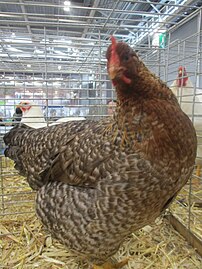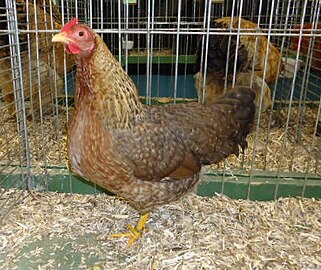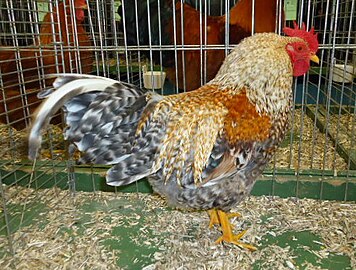Bielefelder Kennhuhn
| Country of origin | Germany |
|---|---|
| Use | dual-purpose, meat and eggs |
| Traits | |
| Weight | |
| Egg colour | brown |
| Classification | |
| APA | no[6] |
| EE | yes[7] |
| PCGB | no[8] |
The Bielefelder Kennhuhn or Bielefelder is a German
History
The concept of an auto-sexing chicken breed goes back to the work of Reginald Punnett in the 1920s and 1930s.[10]: 6
The Bielefelder Kennhuhn was developed in the 1970s in the area of
In 2007 its
Characteristics
The Bielefelder was initially bred in one colour only, crele (German kennsperber) – the cuckoo pattern with black-breasted red colouring. A silver variety (German silber-kennsperber) was later created; it shows the same patterning as in the crele variety, but without any red or yellow colouration. It is a new colour, not seen in any other breed.[10]: 7
Like other breeds with Barred Rock parentage, the Bielefelder is an auto-sexing breed – chicks of different sexes can be distinguished by their colour.[10]: 6
Use
The Bielefelder is dual-purpose breed, well suited to
Bantam hens may give about 160 eggs per year, with an average weight of 49 g.[5]
-
Hen
-
Cock
-
Bantam hen
-
Bantam cock
References
- ^ ISBN 9789251057629. Archived 23 June 2020.
- ^ Breed data sheet: Bielefelder Kennhühner / Germany (Chicken). Domestic Animal Diversity Information System of the Food and Agriculture Organization of the United Nations. Accessed February 2021.
- ^ Breed data sheet: Bielefelder Zwerg-Kennhühner / Germany (Chicken). Domestic Animal Diversity Information System of the Food and Agriculture Organization of the United Nations. Accessed February 2021.
- ^ a b c d e f Rassetafeln: Bielefelder Kennhühner (in German). Bund Deutscher Rassegeflügelzüchter. Accessed February 2021.
- ^ a b c d Rassetafeln: Bielefelder Zwerg-Kennhühner (in German). Bund Deutscher Rassegeflügelzüchter. Accessed February 2021.
- ^ APA Recognized Breeds and Varieties: As of January 1, 2012. American Poultry Association. Archived 4 November 2017.
- ^ Liste des races et variétés homologuée dans les pays EE (28.04.2013). Entente Européenne d’Aviculture et de Cuniculture. Archived 16 June 2013.
- ^ Breed Classification. Poultry Club of Great Britain. Archived 12 June 2018.
- ^ a b c Krystyna Jakubowska, Marcin Różewicz (2018). Charakterystyka wybranych ras kur amatorskich reprezentujących typ ogólnoużytkowy (in Polish). Wiadomości Zootechniczne. 56 (2): 93–103.
- ^ a b c d e f Fritz Schöne (2008). Bielefeler Kennhühner: Attraktiv durch Leistung und Kennfarbigkeit (in German). Geflügelzeitung 18 (2006): 6–8.
- ^ Rassebeschreibungen Hühner (in German). Gesellschaft zur Erhaltung alter und gefährdeter Haustierrassen. Accessed February 2021.




